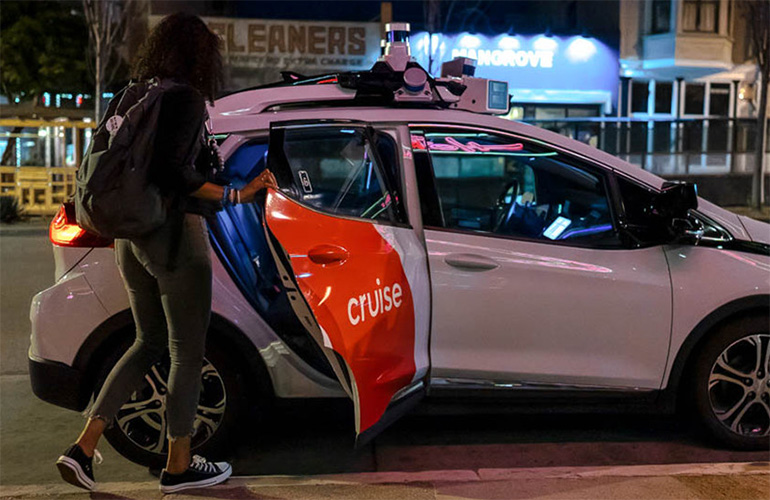|
Listen to this article  |

California’s Department of Motor Vehicles (DMV) on Tuesday morning suspended immediately Cruise’s autonomous vehicle deployment and driverless testing permits. The DMV said the Cruise vehicles are a risk to the public based on a string of recent incidents and that the company “misrepresented” the safety of its robotaxis.
California officials said Cruise, a division of General Motors, didn’t show regulators complete footage of an Oct. 2 incident in downtown San Francisco where a Cruise robotaxi dragged a woman after she was hit by a different car being driven by a human. The Cruise robotaxi was braking but couldn’t avoid striking the pedestrian who was struck by a hit-and-run driver.
According to the DMV, Cruise withheld footage of the incident in which its robotaxi attempted to pull over while the pedestrian was under the vehicle, dragging her for around 20 feet at a speed of 7 MPH before stopping. “Footage of the subsequent movement of the AV to perform a pullover maneuver was not shown to the [DMV] and Cruise did not disclose that any additional movement of the vehicle had occurred after the initial stop,” the DMV wrote.
The DMV said it learned of the subsequent movement “via discussion with another government agency.”
Cruise is disputing that it withheld footage or information from the DMV. Cruise said it showed the complete video to the DMV multiple times during a meeting on Oct. 3 and later provided a copy of the full video to the agency. Cruise posted a blog this morning called “A detailed review of the recent SF hit-and-run incident” with its view of how things unfolded with the incident and subsequent investigation.
The DMV added that “Cruise’s vehicles may lack the ability to respond in a safe and appropriate manner during incidents involving a pedestrian.”
The DMV is allowing Cruise to continue testing with a human safety driver, but it must meet a number of steps to reinstate the suspended permits and restart autonomous operations.
Cruise said it learned of the suspension at 10:30 a.m. this morning, which is about 15 minutes after the DMV issued a press release. Cruise posted the following statement on social media:
“As a result, we will be pausing operations of our driverless AVs in San Francisco. Ultimately, we develop and deploy autonomous vehicles in an effort to save lives. In the incident being reviewed by the DMV, a human hit-and-run driver tragically struck and propelled the pedestrian into the path of the AV. The AV braked aggressively before impact and because it detected a collision, it attempted to pull over to avoid further safety issues. When the AV tried to pull over, it continued before coming to a final stop, pulling the pedestrian forward. Our thoughts continue to be with the victim as we hope for a rapid and complete recovery.
“Shortly after the incident, our team proactively shared information with the California DMV, CPUC, and NHTSA, including the full video. We have stayed in close contact with regulators to answer their questions and assisted the police with identifying the vehicle of the hit-and-run driver. Our teams are currently doing an analysis to identify potential enhancements to the AV’s response to this kind of extremely rare event.”
Just getting started
The suspension comes less than three months after Cruise, and competitor Waymo, received final permits to offer commercial robotaxi services across San Francisco 24 hours a day, seven days a week. Just days after, however, Cruise was involved in a number of incidents, including multiple instances of blocking traffic for periods of time, a collision with an emergency response vehicle, driving over and getting stuck in wet cement, and more.
A string of incidents occurred within days of receiving the CPUC permit, including a collision between a Cruise robotaxi and an emergency vehicle that left a passenger injured. The DMV told Cruise it had to reduce its robotaxi fleet to 50% while the department investigated that incident. That prompted some San Francisco city officials to formally request that state regulators redo an August hearing that expanded robotaxi permits for Cruise and Waymo.
“Public safety remains the California DMV’s top priority, and the department’s autonomous vehicle regulations provide a framework to facilitate the safe testing and deployment of this technology on California public roads,” the DMV said. “When there is an unreasonable risk to public safety, the DMV can immediately suspend or revoke permits. There is no set time for a suspension.”
GM CEO Mary Barra recently said GM believes “Cruise has a tremendous opportunity to grow and expand and that the company could generate $50 billion a year in annual revenue by 2030. On Tuesday, GM reported it lost $732 million on Cruise during the third quarter of 2023.
The Robot Report reached out to Waymo for comment, but Waymo said it is not commenting on the story.
Credit: Source link


Comments are closed.